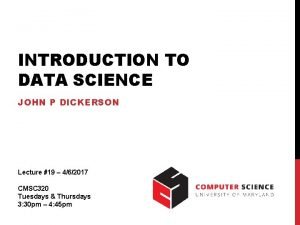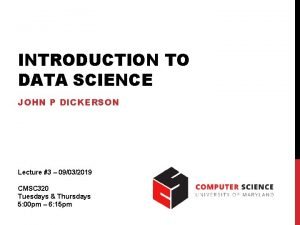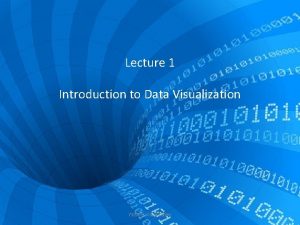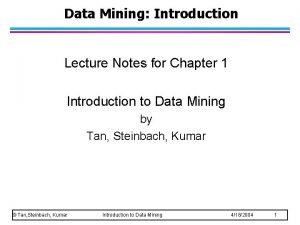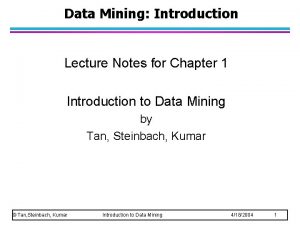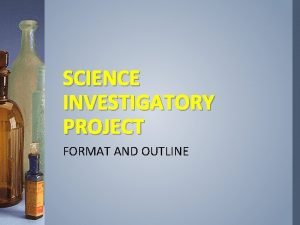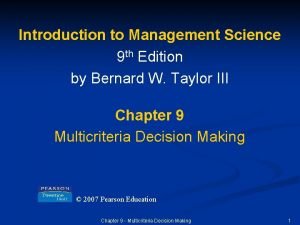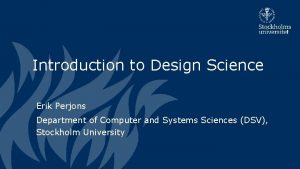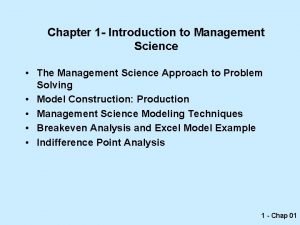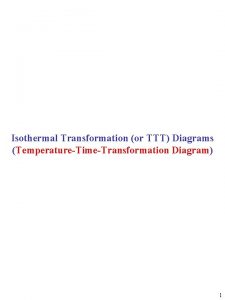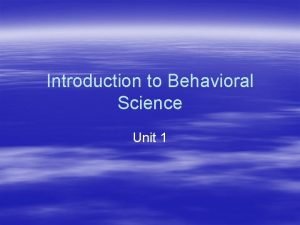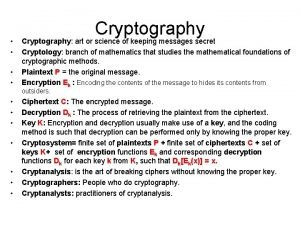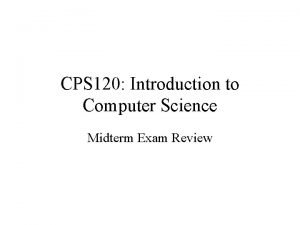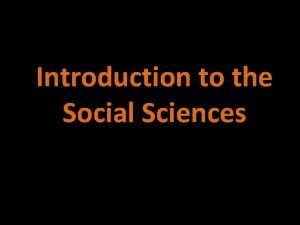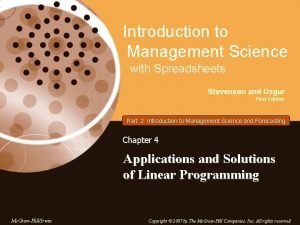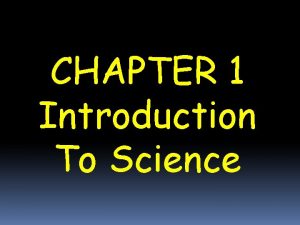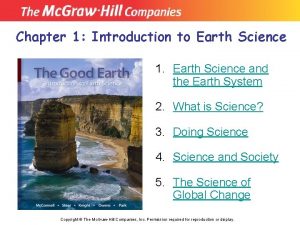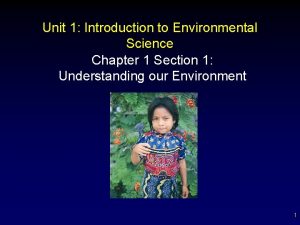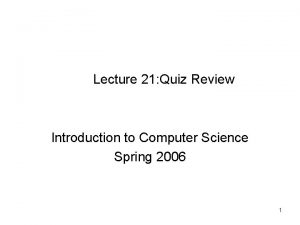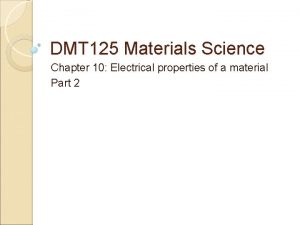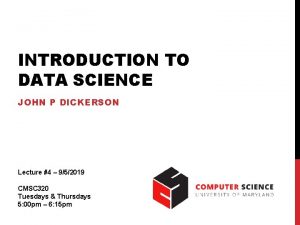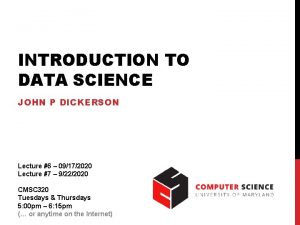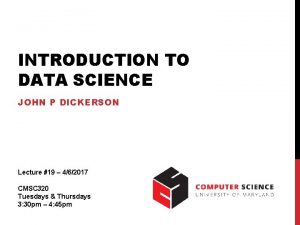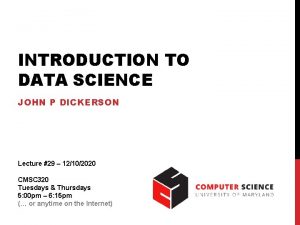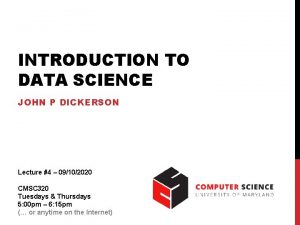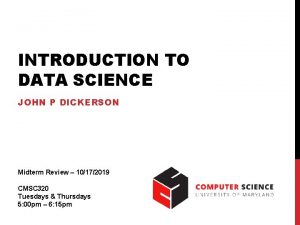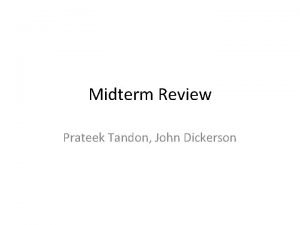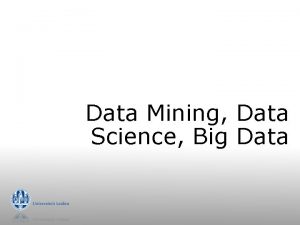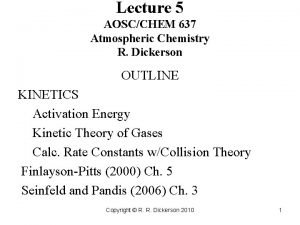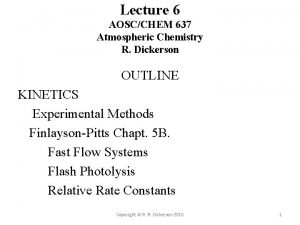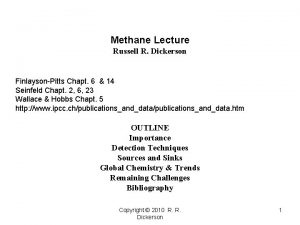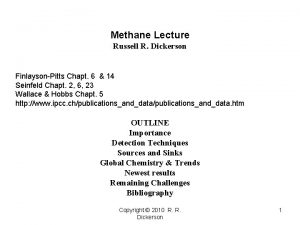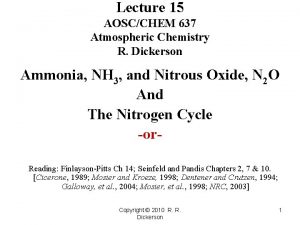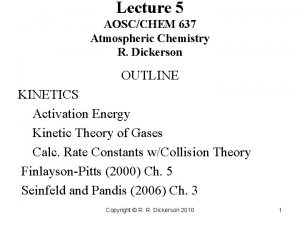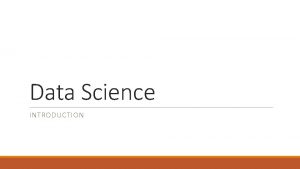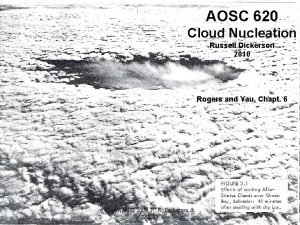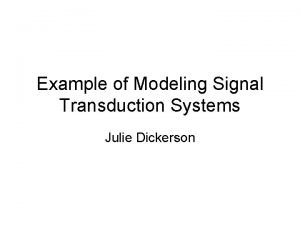INTRODUCTION TO DATA SCIENCE JOHN P DICKERSON Lecture





















































- Slides: 53

INTRODUCTION TO DATA SCIENCE JOHN P DICKERSON Lecture #9 – 9/24/2019 CMSC 320 Tuesdays & Thursdays 5: 00 pm – 6: 15 pm

ANNOUNCEMENTS Mini-Project #1 is due tomorrow night! • It is linked to from ELMS; also available at: https: //github. com/cmsc 320/fall 2019/tree/master/project 1 • Deliverable is a. ipynb file submitted to ELMS Mini-Project #2 will be posted at some point later this week! • It will be linked to from ELMS and on Git. Hub • Deliverable is a. ipynb file submitted to ELMS 2 • Due TBD in October

HANDLING MISSING DATA … 3 Continued from last lecture …

SINGLE IMPUTATION Mean imputation: imputing the average from observed cases for all missing values of a variable Hot-deck imputation: imputing a value from another subject, or “donor, ” that is most like the subject in terms of observed variables • Last observation carried forward (LOCF): order the dataset somehow and then fill in a missing value with its neighbor Cold-deck imputation: bring in other datasets Old and busted: • All fundamentally impose too much precision. • Have uncertainty over what unobserved values actually are 4 • Developed before cheap computation

MULTIPLE IMPUTATION Developed to deal with noise during imputation • Impute once treats imputed value as observed We have uncertainty over what the observed value would have been 5 Multiple imputation: generate several random values for each missing data point during imputation

IMPUTATION PROCESS s 1 a 1 s 2 a 2 Pooled results s. N a. N Impute N times Analysis performed on each imputed set 6 Incomplete data

TINY EXAMPLE X Y 32 2 43 ? 56 6 25 ? 84 5 7 Independent variable: X Dependent variable: Y We assume Y has a linear relationship with X

LET’S IMPUTE SOME DATA! Use a predictive distribution of the missing values: • Given the observed values, make random draws of the observed values and fill them in. X Y 32 2 43 5. 5 43 7. 2 56 6 25 8 25 1. 1 84 5 For very large values of N=2 … 8 • Do this N times and make N imputed datasets

INFERENCE WITH MULTIPLE IMPUTATION Now that we have our imputed data sets, how do we make use of them? ? ? • Analyze each of the separately X Y 32 2 43 5. 5 43 7. 2 56 6 25 8 25 1. 1 84 5 -0. 8245 6. 1845 Y X i 0 1 i Slope Standard error i 4. 932 4. 287 Y X i 0 1 i i 9 Slope Standard error

10 POOLING ANALYSES

PREDICTING THE MISSING DATA GIVEN THE OBSERVED DATA Probability of seeing evidence given the hypothesis Prior probability of hypotheses Prior over the evidence 11 Posterior probability of the hypothesis given the evidence

BAYESIAN IMPUTATION Establish a prior distribution: • Some distribution of parameters of interest θ before considering the data, P(θ) • We want to estimate θ Given θ, can establish a distribution P(Xobs|θ) Use Bayes Theorem to establish P(θ|Xobs) … • Make random draws for θ 12 • Use these draws to make predictions of Ymiss

13 HOW BIG SHOULD N BE?

MORE ADVANCED METHODS Interested? Further reading: • Regression-based MI methods • Multiple Imputation Chained Equations (MICE) or Fully Conditional Specification (FCS) • Readable summary from JHU School of Public Health: https: //www. ncbi. nlm. nih. gov/pmc/articles/PMC 3074241/ • Markov Chain Monte Carlo (MCMC) 14 • We’ll cover this a bit, but also check out CMSC 422!

REST OF TODAY’S LECTURE Data collection Data processing Exploratory analysis & Data viz Analysis, hypothesis testing, & ML Insight & Policy Decision Many slides from Amol Deshpande (UMD) 15 Continue with the general topic of data wrangling and cleaning

OVERVIEW Goal: get data into a structured form suitable for analysis • Variously called: data preparation, data munging, data curation • Also often called ETL (Extract-Transform-Load) process Often the step where majority of time (80 -90%) is spent Key steps: 16 • Scraping: extracting information from sources, e. g. , webpages, spreadsheets • Data transformation: to get it into the right structure • Data integration: combine information from multiple sources • Information extraction: extracting structured information from unstructured/text sources • Data cleaning: remove inconsistencies/errors

OVERVIEW Goal: get data into a structured form suitable for analysis • Variously called: data preparation, data munging, data curation • Also often called ETL (Extract-Transform-Load) process Often the step where majority of time (80 -90%) is spent Key steps: Already covered 17 • Scraping: extracting information from sources, e. g. , webpages, spreadsheets • Data transformation: to get it into the right structure • Information extraction: extracting structured information from In a few unstructured/text sources classes • Data integration: combine information from multiple sources • Data cleaning: remove inconsistencies/errors

18 OVERVIEW

OVERVIEW Many of the problems are not easy to formalize, and have seen little work • E. g. , Cleaning • Others aspects of integration, e. g. , schema mapping, have been studied in depth • Visual (e. g. , Trifacta), or not (UNIX grep/sed/awk, Pandas) • Ad hoc programs for cleaning data, depending on the exact type of errors • Different types of transformation tools • Visualization and exploratory data analysis to understand remove outliers/noise • Several tools for setting up the actual pipelines, assuming the individual steps are setup (e. g. , Talend, AWS Glue) 19 A mish-mash of tools typically used

OUTLINE • Data Integration • Data Quality Issues • Data Cleaning 20 • Entity Resolution

OUTLINE • Data Integration • Data Quality Issues • Data Cleaning 21 • Entity Resolution

DATA INTEGRATION • Discovering information sources (e. g. deep web modeling, schema learning, …) • Gathering data (e. g. , wrapper learning & information extraction, federated search, …) • Cleaning data (e. g. , de-duping and linking records) to form a single [virtual] database Queries • Querying integrated information sources (e. g. queries to views, execution of web-based queries, …) • Data mining & analyzing integrated information (e. g. , collaborative filtering/classification learning using extracted data, …) 22 Linkage

DATA INTEGRATION Goal: Combine data residing in different sources and provide users with a unified view of these data for querying or analysis • Each data source has its own schema called local schemas (much work assumes relational schemas, but some work on XML as well) • The unified schema is often called mediated schema or global schema 1. Bring the data together into a single repository (often called data warehousing) 2. Keep the data where it is, and send queries back and forth 23 Two different setups:

1. DATA WAREHOUSING From Data Cleaning: Problems and Current Approaches Many of the problems are not easy to formalize, and have seen little work • E. g. , Cleaning • Others aspects of integration, e. g. , schema mapping, have been studied in depth Typical workflow 24 • From Data Cleaning: Problems and Current Approaches • Somewhat old: data is mostly coming from structured sources • For a data scientist, the data scraping is equally important

2. IN-PLACE INTEGRATION Query Q Mediated Schema Q’ Source Q’ Q’ Source

DATA INTEGRATION Two different setups: 1. Bring the data together into a single repository (often called data warehousing) • Relatively easier problem - only need one-way-mappings • Query performance predictable and under your control Keep the data where it is, and send queries back and forth • Need two-way mappings -- a query on the mediated schema needs to be translated into queries over data source schemas • Not as efficient and clean as data warehousing, but a better fit for dynamic data • Or when data warehousing is not feasible 26 2.

DATA INTEGRATION: KEY CHALLENGES • Get the data from each source in a structured form • Often need to use wrappers to extract data from web sources • May need to define a schema Schema alignment and mapping • Decide on the best mediated schema • Figure out mappings and matchings between the local schemas and the global schema Answer queries over the global schema • In the second scenario, need to figure out how to map a query on global schema onto queries over local schemas • Also need to decide which sources contain relevant data Limitations in mechanisms for accessing sources • Many sources have limits on how you can access them • Limits on the number of queries you can issues (say 100 per min) • Limits on the types of queries (e. g. , must enter a zipcode to get information from a web source) 27 Data extraction, reconciliation, and cleaning

Flashbacks to Project 1 … SCHEMA MATCHING OR ALIGNMENT Goal: Identify corresponding elements in two schemas • As a first step toward constructing a global schema • Schema heterogeneity is a key roadblock • Different data sources speak their own schema Hotel, Restaurant, Adventure. Sports, Historical. Sites Data Source Consumer Hotel, Gaststätte Brauerei, Kathedrale Mediator Data Source Lodges, Restaurants Beaches, Volcanoes 28 Data Source

SCHEMA MATCHING OR ALIGNMENT Books. And. Music Title Author Publisher Item. ID Item. Type Suggested. Price Categories Keywords Inventory Database A Title ISBN Price Discount. Price Edition Authors ISBN First. Name Last. Name Book. Categories ISBN Category CDCategories ASIN Category CDs Album ASIN Price Discount. Price Studio Artists ASIN Artist. Name Group. Name Inventory Database B

SUMMARY • Data integration continues to be a very active area in research and increasingly industry • Solutions still somewhat ad hoc and manual, although tools beginning to emerge • Need to minimize the time needed to integrate a new data source • Crucial opportunities may be lost otherwise • Can take weeks to do it properly • Dealing with changes to the data sources a major headache 30 • Especially for data sources not under your control

OUTLINE • Data Integration • Data Quality Issues • Data Cleaning 31 • Entity Resolution

DATA QUALITY PROBLEMS Different sources are developed separately, and maintained by different people Issue 1: Mapping information across sources (schema mapping/transformation) • Naming conflicts: same name used for different objects • Structural conflicts: different representations across sources • We will cover this later Issue 2: Entity Resolution: Matching entities across sources Issue 3: Data quality issues From Data Cleaning: Problems and Current Approaches 32 • Contradicting information, Mismatched information, etc.

SINGLE-SOURCE PROBLEMS Depends largely on the source Databases can enforce constraints, whereas data extracted from files or spreadsheets, or scraped from webpages is much more messy Types of problems: 33 • Ill-formatted data, especially from webpages or files or spreadsheets • Missing or illegal values, Misspellings, Use of wrong fields, Extraction issues (not easy to separate out different fields) • Duplicated records, Contradicting Information, Referential Integrity Violations • Unclear default values (e. g. , data entry software needs something) • Evolving schemas or classification schemes (for categorical attributes) • Outliers

34 DATA QUALITY PROBLEMS

MULTI-SOURCE PROBLEMS Different sources are developed separately, and maintained by different people Issue 1: Mapping information across sources (schema mapping/transformation) • Naming conflicts: same name used for different objects • Structural conflicts: different representations across sources • We will cover this later Issue 2: Entity Resolution: Matching entities across sources Issue 3: Data quality issues 35 • Contradicting information, Mismatched information, etc.

OUTLINE • Data Integration • Data Quality Issues • Data Cleaning • Outlier Detection • Constraint-based Cleaning 36 • Entity Resolution

UNIVARIATE OUTLIERS A set of values can be characterized by metrics such as center (e. g. , mean), dispersion (e. g. , standard deviation), and skew Can be used to identify outliers • Must watch out for "masking": one extreme outlier may alter the metrics sufficiently to mask other outliers • Should use robust statistics: considers effect of corrupted data values on distributions – we will talk about this in depth later • Robust center metrics: median, k% trimmed mean (discard lowest and highest k% values) • Robust dispersion: • Median Absolute Deviation (MAD): median distance of all the values from the median value • The above assumes that data follows a normal distribution • May need to eyeball the data (e. g. , plot a histogram) to decide if this is true 37 A reasonable approach to find outliers: any data points 1. 4826 x MAD away from median

UNIVARIATE OUTLIERS Wikipedia Article on Outliers lists several other normality-based tests for outliers If data appears to be not normally distributed: • Distance-based methods: look for data points that do not have many neighbors • Density-based methods: • Define density to be average distance to k nearest neighbors • Relative density = density of node/average density of its neighbors • Use relative density to decide if a node is an outlier Most of these techniques start breaking down as the dimensionality of the data increases • Not as straightforward 38 • Curse of dimensionality • Can project data into lower-dimensional space and look for outliers there

OTHER OUTLIERS Timeseries outliers • Often the data is in the form of a timeseries • Can use the historical values/patterns in the data to flag outliers • Rich literature on forecasting in timeseries data Frequency-based outliers • An item is considered a "heavy hitter" if it is much more frequent than other items • In relational tables, can be found using a simple groupby-count • Often the volume of data may be too much (e. g. , internet routers) • Approximation techniques often used • To be discussed sometime later in the class • Outlier detection continues to be a major research area 42 Things generally not as straightforward with other types of data

WRAP-UP Data wrangling/cleaning are a key component of data science pipeline Still largely ad hoc although much tooling in recent years Specifically, we covered: • Schema mapping and matching • Outliers Next up: • Constraint-based Cleaning 43 • Entity Resolution/Record Linkage/Data Matching

DATA CLEANING: OUTLIER RESOLUTION From: Entity Resolution Tutorial Identify different manifestations of the same real world object • Also called: identity reconciliation, record linkage, deduplication, fuzzy matching, Object consolidation, Coreference resolution, and several others Motivating examples: ? ? ? ? Postal addresses Entity recognition in NLP/Information Extraction Identifying companies in financial records Comparison shopping Author disambiguation in citation data Connecting up accounts on online networks Crime/Fraud Detection Census. . . 44 • • •

DATA CLEANING: OUTLIER RESOLUTION Important to correctly identify references • Often actions taken based on extracted data • Cleaning up data by entity resolution can show structure that may not be apparent before Challenges • Such data is naturally ambiguous (e. g. , names, postal addresses) • Abbreviations/data truncation • Data entry errors, Missing values, Data formatting issues complicate the problem • Heterogeneous data from many diverse sources No magic bullet here !! 45 • Approaches fairly domain-specific • Be prepared to do a fair amount of manual work

ENTITY RESOLUTION: THREE SLIGHTLY DIFFERENT PROBLEMS Setup: • Real world: there are entities (people, addresses, businesses) • We have a large collection of noisy, ambiguous "references" to those entities (also called "mentions") • Somewhat different techniques, but a lot of similarities Deduplication • Cluster records/mentions that correspond to the same entity • Choose/construct a cluster representative 46 • This is in itself a non-trivial task (e. g. , averaging may work for numerical attributes, but what about string attributes? )

ENTITY RESOLUTION: THREE SLIGHTLY DIFFERENT PROBLEMS Setup: • Real world: there are entities (people, addresses, businesses) • We have a large collection of noisy, ambiguous "references" to those entities (also called "mentions") • Somewhat different techniques, but a lot of similarities Record Linkage 47 • Match records across two different databases (e. g. , two social networks, or financial records w/ campaign donations) • Typically assume that the two databases are fairly clean

ENTITY RESOLUTION: THREE SLIGHTLY DIFFERENT PROBLEMS Setup: • Real world: there are entities (people, addresses, businesses) • We have a large collection of noisy, ambiguous "references" to those entities (also called "mentions") • Somewhat different techniques, but a lot of similarities Reference Matching 48 • Match "references" to clean records in a reference table • Commonly comes up in "entity recognition" (e. g. , matching newspaper article mentions to names of people)

ENTITY RESOLUTION: DATA MATCHING Comprehensive treatment: Data Matching; P. Christen; 2012 (Springer Books -- not available for free) One of the key issues is finding similarities between two references • What similarity function to use? Edit Distance Functions • Levenstein: min number of changes to go from one reference to another • A change is defined to be: a single character insertion or deletion or substitution • May add transposition • Many adjustments to the basic idea proposed (e. g. , higher weights to changes at the start) • Not cheap to compute, especially for millions of pairs Set Similarity • Cosine similarity – we’ll talk about this much more in NLP lectures 49 • Some function of intersection size and union size • E. g. , Jaccard distance = size of intersection/size of union • Much faster to compute Vector Similarity

ENTITY RESOLUTION: DATA MATCHING Q-Grams • Find all length-q substrings in each string • Use set/vector similarity on the resulting set Several approaches that combine the above (especially q-grams and edit distance, e. g. , Jaro-Winkler) Soundex: Phonetic Similarity Metric • Homophones should be encoded to the same representation so spelling errors can be handled • Robert and Rupert get assigned the same code (R 163), but Rubin yields R 150 May need to use Translation Tables • To handle abbreviations, nicknames, other synonyms Different types of data requires more domain-specific functions 50 • E. g. , geographical locations, postal addresses • Also much work on computing distances between XML documents etc.

ENTITY RESOLUTION: ALGORITHMS Simple threshold method • If the distance below some number, the two references are assumed to be equal • May review borderline matches manually Can be generalized to rule-based: 51 • Example from Christen, 2012

ENTITY RESOLUTION: ALGORITHMS May want to give more weight to matches involving rarer words • More naturally applicable to record linkage problem • If two records match on a rare name like "Machanavajjhala", they are likely to be a match • Can formalize this as "probabilistic record linkage” Constraints: May need to be satisfied, but can also be used to find matches • Often have constraints on the matching possibilities • Transitivity: M 1 and M 2 match, and M 2 and M 3 match, and M 1 and M 3 must match • Exclusivity: M 1 and M 2 match --> M 3 cannot match with M 2 • Other types of constraints: 52 • E. g. , if two papers match, their venues must match

ENTITY RESOLUTION: ALGORITHMS Clustering-based ER Techniques: Deduplication is basically a clustering problem Can use clustering algorithms for this purpose But most clusters are very small (in fact of size = 1) Some clustering algorithms are better suited for this, especially Agglomerative Clustering • Unlikely K-Means would work here 53 • •

ENTITY RESOLUTION: ALGORITHMS Crowdsourcing 54 • Humans are often better at this task • Can use one of the crowdsourcing mechanisms (e. g. , Mechanical Turk) for getting human input on the difficult pairs • Quite heavily used commercially (e. g. , to disambiguate products, restaurants, etc. )

ENTITY RESOLUTION: SCALING TO BIG DATA One immediate problem • There are O(N 2) possible matches • Must reduce the search space Use some easy-to-evaluate criterion to restrict the pairs considered further • May lead to false negative (i. e. , missed matches) depending on how noisy the data is Much work on this problem as well, but domain-specific knowledge likely to be more useful in practice One useful technique to know: min-hash signatures 55 • Can quickly find potentially overlapping sets • Turns up to be very useful in many domains (beyond ER)

NEXT CLASS: 56 SUMMARY STATISTICS &VISUALIZATION
 John p. dickerson
John p. dickerson Cmsc 320 github
Cmsc 320 github Sally dickerson
Sally dickerson Evan dickerson
Evan dickerson 01:640:244 lecture notes - lecture 15: plat, idah, farad
01:640:244 lecture notes - lecture 15: plat, idah, farad That's my favorite
That's my favorite Sciencefusion think central
Sciencefusion think central Physical science lecture notes
Physical science lecture notes Introduction to biochemistry lecture notes
Introduction to biochemistry lecture notes Introduction to psychology lecture
Introduction to psychology lecture Introduction to algorithms lecture notes
Introduction to algorithms lecture notes Exploratory data analysis lecture notes
Exploratory data analysis lecture notes Bayesian classification in data mining lecture notes
Bayesian classification in data mining lecture notes Data mining lecture notes
Data mining lecture notes Data visualization lecture
Data visualization lecture Data mining lecture notes
Data mining lecture notes Data mining lecture notes
Data mining lecture notes Introduction to data mining and data warehousing
Introduction to data mining and data warehousing John jay science and engineering academy
John jay science and engineering academy Social science vs natural science
Social science vs natural science Mind map main branches of science
Mind map main branches of science Natural and physical science
Natural and physical science Applied science vs pure science
Applied science vs pure science Anthropology vs sociology
Anthropology vs sociology Rule of 70 in population growth
Rule of 70 in population growth Windcube
Windcube Soft science definition
Soft science definition Introduction to hospitality 7th edition
Introduction to hospitality 7th edition Tourism the business of hospitality and travel 5th edition
Tourism the business of hospitality and travel 5th edition The flea poet
The flea poet Introduction of john donne
Introduction of john donne John r walker introduction to hospitality management
John r walker introduction to hospitality management Investigatory project research paper
Investigatory project research paper Introduction to management science chapter 5 solutions
Introduction to management science chapter 5 solutions Erik perjons
Erik perjons Introduction to management science chapter 1 solutions
Introduction to management science chapter 1 solutions Forensic science powerpoint
Forensic science powerpoint Introduction to materials science for engineers chapter 10
Introduction to materials science for engineers chapter 10 Introduction to behavioral science
Introduction to behavioral science It is the art of keeping messages secure.
It is the art of keeping messages secure. Introduction to computer science midterm exam
Introduction to computer science midterm exam Introduction to computer science midterm exam test
Introduction to computer science midterm exam test Define social science
Define social science Introduction to management science with spreadsheets
Introduction to management science with spreadsheets Unit 1 introduction to forensic science
Unit 1 introduction to forensic science Chapter 1 introduction to science
Chapter 1 introduction to science Chapter 1 introduction to earth science
Chapter 1 introduction to earth science Weather studies introduction to atmospheric science
Weather studies introduction to atmospheric science Unit 1 introduction to environmental science
Unit 1 introduction to environmental science Introduction to computer science quiz
Introduction to computer science quiz Introduction to earth science
Introduction to earth science Introduction to materials science for engineers chapter 10
Introduction to materials science for engineers chapter 10 Forensic science an introduction
Forensic science an introduction Chapter 1 introduction to forensic science and the law
Chapter 1 introduction to forensic science and the law
